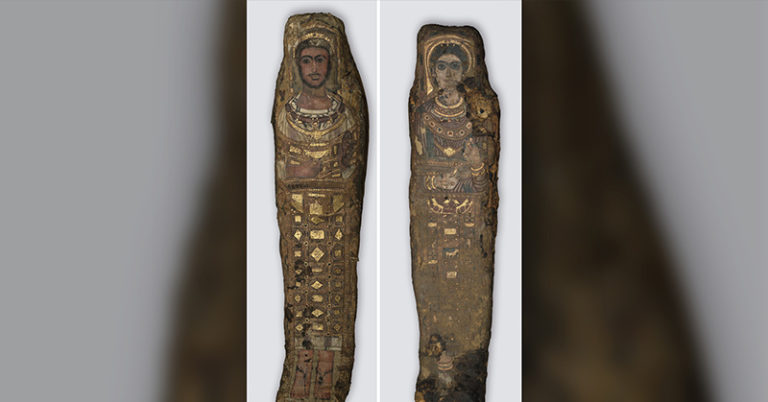Many people who viewed tombs and Egyptian mummies felt the same curiosity. Who were these ancient people before they were mummies? It seemed that their stories would remain “shrouded” in mystery until scientists found a new way to reveal them.
Two Egyptian mummies were found in a tomb over 400 years ago. A new study put these two mummies’ remains through a CT scan. The researchers then added a third mummy that was previously on display. This trio is the only known mummies from Saqqara, an ancient Egyptian cemetery. Most Egyptian mummies are entombed in coffins; however, these ones lay on wood slates, wrapped in a shroud, and decorated with a full-body portrait.
The lead researcher of the study is Stephanie Zesch, a physical anthropologist and Egyptologist at the German Mummy Project at Reiss Engelhorn Museum in Mannheim, Germany. Among many other details, the CT scans of these “stucco-shrouded portrait mummies” found preserved organs and necklaces. [1]
The History of the Egyptian Mummies
The male and female mummies had traveled a lot since their demise. They were discovered in 1615 by an Italian composer named Pietro Della Valle. He traveled through Egypt on a pilgrimage to Israel and heard about the stucco-shrouded portrait mummies in Saqqara. He brought them back to Rome. There they became the “earliest examples of portrait mummies to have become known in Europe”.
The Egyptian mummies passed hands many times until they landed at the Dresden State Art Collections in Germany. In the 80s, studies conducted X-rays on mummies. However, the CT scans conducted revealed a lot more of their history and personal details.
What the CT Scans Found
These details included the fact that the man died in his late 20s, was 5”4 inches tall, and his mouth contained cavities and two unerupted permanent teeth. While in transit after his initial discovery, several of his bones broke and became jumbled, the researchers hypothesize.
The woman had stood at 4”11 inches tall, passed away at 30 to 40 years of age, and suffered from advanced arthritis in her left knee.
The teenager had a benign tumor in her spine and had died at around 17 to 19. She was 5”1 inches tall.
Unfortunately, it’s unclear whether one of these medical issues caused any of their deaths.
“The examination of the individuals yielded that they died at rather young ages…” said Zesch. “However, the cause of death of the individuals could not be determined.”
The CT scans dated the deaths of the trio to the late Roman period (30 B.C. to A.D. 395). Their wrappings included objects such as coins. Mummies sometimes kept coins as payment to Charon, the deity from Greek and Roman mythology, who’s responsible for transporting souls to the afterlife.
The Process of Mummification
Mummification usually involves extracting the brain through the nostrils, preserving the organs in separate jars, drying out the body, and inserting preservatives in it. [2]
Interestingly, the man’s skull didn’t contain the brain. However, there was no sign of the typical extraction through-the-nose process. The body also lacked many of the expected preservatives. His mummification included the process of wrapping and painting. Two pieces of metal that may have served as seals came up on the scan. The teenager’s brain and organs were still present in the body.
“We are quite sure there was no removing the brain or the internal organs,” Zesch said. “It’s very probable that those mummies were only preserved because of a kind of dehydration with the use of [the desiccation mixture] natron, but there is not a huge amount of embalming liquids.”
The teenager and the woman wore multiple beaded necklaces. The girl also had a hairpin. This is not a surprise because their burial methods signified wealth. The teen’s shroud includes the hairpin as well.
As Zesch explained, “Because of these very precious shrouds, we are sure that those individuals have to be members of the higher socioeconomic class.”
What the researchers couldn’t explain the metal nails in the abdomen of the woman, unlike the coins and medallions by her hand, which may have been payment to Charon or a sign of wealth.
Preserving the History of Egyptian Mummies
These artifacts and the style of mummification helped determine the time period these people lived in, as well as their spiritual beliefs. For example, the shrouds depicted Greek and Egyptian gods.
Zesch studied the Egyptian mummies with a team of researchers from the Institute for Mummy Studies at Eurac Research in Bolzano, Italy, the Dresden State Art Collections, the German Mummy Project, the American-Egyptian Horus Study Group, and the Dresden State Art Collections. The teenager mummy is now residing at the Museum of Egyptian Antiquities in Cairo. The other two mummies are part of a live exhibit of this research in Dresden.
“The three stucco-shrouded portrait mummies represent unique examples of the artificial mummification tradition practiced at the Saqqara necropolis at the end of the Roman Period,” concludes the research paper. “They are moreover considered as valued cultural heritage due to their exceptional collection history and intact preservation.” [3]
Keep Reading: Scientists May Have Determined The Maximum Age A Human Can Live To
- ‘Archaeologists finally peer inside Egyptian mummies first found in 1615’ Live Science Laura Geggel. Published November 10, 2020
- ‘Egyptian Mummies’ Smithsonian.
- ‘Decorated bodies for eternal life: A multidisciplinary study of late Roman Period stucco-shrouded portrait mummies from Saqqara (Egypt).’ PLOS OneStephanie Zesch. Published November 4, 2020

